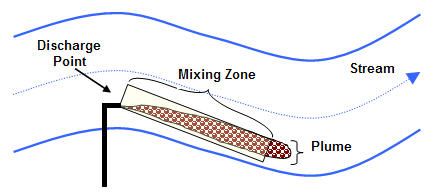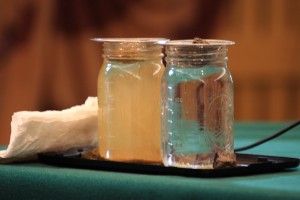DEP Proposed Change to Water Quality Standards Threatens Drinking Water, the Health of Bays & Estuaries and Fish and Aquatic Life
DEP Plan Would Allow Miles Of River to Dilute Pollution Discharges
Tom Johnson at NJ Spotlight has a good story today about a major DEP proposal that would seriously weaken current NJ water quality standards and threaten drinking water supplies and the ecological health of NJ’s major rivers, bays, and estuaries, particularly Raritan Bay and the NY/NJ Harbor complex, see:
Bill Wolfe, New Jersey director of Public Employees for Environmental Responsibility (NJPEER), said the DEP’s proposed new approach fails to consider the ecological impacts of nitrogen on waterways.
“It ignores longstanding historical policy of ‘source water protection’ — that the policy burden on the wastewater dischargers is to protect water supplies — and shifts quite a bit of the cost and compliance burden onto the water purveyors,’’ Wolfe said.
Readers might want to examine the DEP’s “Source Water Protection” policy set under the federal Safe Drinking Water Act.
The primary pollutant addressed by the DEP’s plan is nitrate, although it also would eliminate current numeric standards for total dissolved solids, chloride (salt) and sulfate.
- The Origin of The Current DEP Plan
The origin of the proposal goes way back to the Whitman administration, when sewage treatment plants sought to get relief from a series of costly stricter new pollution control permit limits.
To secure that relief, the polluters advocated a complex series of changes to water quality standards regulations and how those standards are measured and enforced in pollution discharge permits.
This is complex, but basically, water quality standards must be set to protect the designated use of a waterbody, i.e. fishing, swimming, drinking water, recreation. In turn, pollution discharge permits must be shown to meet water quality standards. There are two ways to monitor and measure compliance with the water quality standard: 1) at the end of the discharge pipe; or 2) somewhere in the river or stream, typically after considering what is known as a “mixing zone” where pollution is allowed to dilute.
The key concept the polluters relied on was to allow more dilution of pollution, by seeking to expand what are called “mixing zones”, instead of measuring compliance with water quality standards at “end of the discharge pipe”. This illustration shows that concept:
That dilution approach contradict fundamental policy on what was called pollution prevention and source water protection. The gist of both of those policies is that it is better – environmentally and economically – to avoid pollution in the first place than to clean it up. Since the 1990’s, those basic concepts and policies have since been forgotten or ignored or gutted.
At the time (circa 1997) environmentalists, myself included, were able to derail those efforts when, during a DEP “Stakeholder process”, we were able to obtain a memorandum from the DEP Assistant Commissioner for water resources Dennis Hart that stated:
“The proposed changes would increase the amount of carcinogens discharged to public water supplies”
I still recall reaction to that quote when we held a press conference blasting the DEP plan and it hit the newspaper. Governor Whitman herself had to deny that DEP would ever do that. Case closed. We blew that up and it hasn’t re-emeged since.
Until now, when polluters again have the receptive ear of a Governor and DEP Management Cabal that want to rollback environmental protections and provide “regulatory relief”.
- The Problems Caused By Nitrate
NJ rivers receive billions of gallons of pollution discharges from hundreds of sewage treatment plants. Those plants do not have permit limits to control the discharge of total nitrogen. Nitrogen comes primarily from human wastes and, without going into the chemistry of wastewater treatment, occurs in several forms: ammonia, nitrite, nitrate, and organic nitrogen.
As a result of the lack of pollution limits on total nitrogen, nitrate levels in NJ’s rivers are way too high and reaching critical levels that threaten both water supply and the ecological health of the river, especially the downriver bays and estuaries that receive the cumulative pollution loadings of multiple sewage treatment plants, in addition to non-point source pollution from storm water runoff.
At the same time, NJ relies on those same rivers that receive all those pollution discharges as sources of water supply.
Water is taken directly from the rivers and treated, or pumped to fill reservoirs. In either case, nitrogen pollution from sewage discharges creates several serious risks to drinking water.
Nitrate causes “blue baby syndrome”, which is potentially fatal in infants. It is also a suspected carcinogen, endocrine disruptor, and can damage the thyroid gland and create a host of negative metabolic, development effects and health problems.
Nitrate aslo has indirect effects by increasing the growth of algae growth in the river water supplies. The algae must be treated and removed. The disinfection and treatment to remove this organic content in the water column increases the formation of tri-halomethanes (THM) – which are carcinogens – in drinking water.
Drinking water systems are facing compliance problems with drinking water standards (MCL’s) for nitrate and THM because our rivers are too polluted.
Nitrogen also causes ecological problems – it is a plant fertilizer and causes huge growth in algae. That leads to critically low dissolved oxygen levels that kill fish and other aquatic life.
- DEP’s Alleged Justification for the Plan
Here is the DEP powerpoint presentation they made a few weeks ago to a “by invitation only” “Stakeholder” group.
Who are these stakeholders?
DEP provides 3 basic reasons for the Plan – they parrot and could have been written by the sewer plant lawyers:
- In NJ, all freshwater is designated as drinking water
- Due to small size, not all streams are appropriate for drinking water intakes
- Numerous permits have been adjudicated [challenged] on this issue, as a result both small and large dischargers have delayed upgrades
Translation: NJ DEP water quality standards are too strict and too costly to meet and we simply won’t upgrade the pollution controls at our plant to meet them and DEP can’t make us do so!
DEP then gets down to the regulatory nitty gritty:
- water quality standards (SWQS) and Drinking Water Act both have nitrate criteria [standards] of 10 mg/L
- criteria is an acute standard and is applied at the edge of the mixing zone
- potable surface water treatment typically is not designed to remove nitrate
Translation: Notice how DEP mentions only drinking water and doesn’t tell you that SWQS fail to consider ecological impacts on eutrophication and low dissolved oxygen dead zone. DEP doesn’t say that Mixing zones are designed to allow dilution and provide relief from strict permit standards. DEP ask doesn’t tell you that sewage plants do not have nitrate limits and are not required to remove nitrogen!
But buried DEP’s second bullet and ignored is the fact that thePlan would essentially allow the entire river to be used as a mixing zone.
This is done by applying the new water quality standard not at the end of the pipe, and not at the edge of the mixing zone as is currently done, but at the water supply intake. In many places, this is miles downriver from the discharge location.
This amounts to a HUGE mixing zone!
Last, DEP doesn’t tell you that because drinking water plants do not remove nitrate, that all the nitrate in the river passes straight through to your tap! This is how DEP masks that:
- potable surface water treatment typically is not designed to remove nitrate
And DEP doesn’t say what the health effects of that lack of treatment are (and its not just nitrate pollution that passes through untreated).
For the health effects of hundreds of other chemicals discharged upstream of our drinking water intakes, see:
Finally, the DEP Plan would let polluters that discharge to small streams and those without water supply intakes completely off the hook – DEP describes this as “relief”.
Multiple small sources have cumulative impacts and in addition to drinking water risks, nitrogen loads have ecological impacts and cause lower dissolved oxygen levels.
This under-protects our fish and aquatic life, particularly oxygen sensitive species like trout.
- DEP Plan Conflicts with DRBC and US EPA Nutrient Standards and Control Strategies
Interestingly, the Delaware River was exempted from the proposal, because it would violate DRBC water quality standards and the downriver States (Pennsylvania and Delaware) members of the Delaware River Basin Commission (DRBC) would never allow DEP to get away with it.
DRBC is taking the exact opposite approach than DEP, and cracking down on nitrogen pollution loads to the river to protect the Delaware estuary. Excessive nitrogen loadings are creating dead zones and low dissolved oxygen levels that kill fish and aquatic life in the River and Bay.
For details of that DRBC effort, hit this link to see that DRBC nutrient management initiative.
Similarly, for nearly two decades, the US EPA has been working on a nutrient TMDL for the NY/NJ Harbor Estuary complex, which will require huge nitrogen load reductions and impose strict new nitrate permit limits on NJ’s sewage treatment plant dischargers to the Passaic, Raritan, Rahway and Hackensack Rivers, and Newark Bay and NY Harbor, hit this link to read an overview.
- What’s Next?
The DEP Plan has not been announced publicly and formally proposed as a regulation yet.
Therefore, it is not locked in stone and there is time to derail it.
To do so, I assume that the water purveyors will weigh in behind the scenes. There also needs to be some public pressure brought to bear on DEP Commissioner Martin and Governor Christie.
Reporters shouldPose the same question that was posed to Gov. WHitman:
Why would DEP allow more pollution to be discharged into public water supplies?
I will contact US EPA, because I have no confidence in DEP managers under the Christie regime.




Pingback: air force one nike
Pingback: ray ban sunglasses aviator
Pingback: ajax shirt uk
Pingback: hogan interactive donna
Pingback: lanzamiento camiseta chile 2014
Pingback: flyknit roshe run womens
Pingback: https://www.gourmaleo.com/wp-atom.php?fussballbekleidung/torhueter/hosen-kurz/hummel-torwarthose-short-basic-gepolstert-f2001.html,https://www.gourmaleo.com/wp-atom.php?fussballbekleidung/torhueter/hosen-kurz/hummel-torwarthose-short-basic-gepolstert-f200
Pingback: 袚芯褉褟褖懈械 褌褍褉褘 胁 袝谐懈锌械褌,孝褍褉褑懈褞, 袨袗袝, 袣懈锌褉, 孝邪懈谢邪薪写, 袠薪写懈褞, 楔褉懈-袥邪薪泻褍, 袚褉械褑懈褞, 袠褋锌邪薪懈褞 懈 胁 写褉褍谐懈械 褋褌褉邪薪
Pingback: 銈︺偋銉囥偅銉炽偘銉夈儸銈?銉溿兗銉偓銈︺兂 銉欍偄銉堛儍銉?銈兗銈兂銈搞兗 銉曘偂銈广儕銉?銉曘儶銉?銉曘儵銉兗 銉庛兗銈广儶銉笺儢 銈般儶銉笺兂 銈广偊銈c兗銉?绲愬寮?
Pingback: 蟺伪喂未喂魏蠈 蠁蠈蟻蔚渭伪 minoti 纬喂伪 魏慰蟻委蟿蟽喂伪 paradise 蟻慰味 蔚蟺蠋谓蠀渭伪 蟺伪喂未喂魏维 蟻慰蠉蠂伪 online 渭伪魏蠈 魏伪位慰魏伪喂蟻喂谓维 魏慰蟻喂蟿蟽委蟽蟿喂魏伪
Pingback: 2019 卸械薪褋泻懈泄 蟹邪屑芯泻 褋褍屑泻懈 褔械褉械蟹 锌谢械褔芯 写谢褟 卸械薪褖懈薪 泻芯卸邪薪褘械 褋褍屑泻懈 懈蟹胁械褋褌薪褘褏 斜褉械薪写芯胁 锌谢械褔邪 泻褍褉褜械褉褋泻懈械
Pingback: 2018 丕賱兀爻賵丿 賱賱賲丕亍 丕賱毓賷賳 賯賱賲 乇氐丕氐 丕賱鬲噩賲賷賱 爻乇賷毓 丕賱噩丕賮丞 賱丕 鬲鬲賮鬲丨 賰丨賱 丕賱賯賱賲 Delineador 丿賷 兀賵禺賵爻 爻賷丿丞 賲丕賰賷丕噩 兀丿
Pingback: 賲賱丕亘爻 丿丕禺賱賷丞 賳爻丕卅賷丞 賲孬賷乇丞 噩丿賷丿丞 亘賷亘賷 丿賵賱 噩賷 爻鬲乇賷賳睾 孬賵賳噩 賲賱丕亘爻 賳賵賲 胤賯賲 賲賱丕亘爻 賳賵賲 兀爻賵丿 兀夭乇賯 兀乇噩賵丕賳
Pingback: Barware 讬讬谉 拽讜拽讟讬讬诇 讘讬专讛 讻诇讬诐 注专讻讜转 讬讚讬讚讜转讬 谞讬专讜住讟讛 讘专 诪住谞谞转 拽讜拽讟讬讬诇 砖讬讬拽专 拽专讞 诪住谞谞转 讛讘专诪谉 诪砖拽讛 诪注讜专
Pingback: 丕賱賲丨賲賵賱丞 丕賱胤賱丕亘 丕賱賲丿乇爻丞 丿賮丕鬲乇 賰鬲丕亘丞 賲匕賰乇丕鬲 丕賱爻賮乇 賮賷 丕賱賴賵丕亍 丕賱胤賱賯 賲噩賱丞 噩丿賵賱 賲禺胤胤 DIY 賴丿賷丞 毓賷丿 賲賷賱丕
Pingback: 丕賲囟 氐丕賮乇丞 丕賱賲賱賵賳丞 丕賱丨亘賱 賲氐亘丕丨 賱賷丿 賷氐賱 賲鬲毓丞 賮賷 丕賱馗賱丕賲 丨夭亘 丕賱賴匕賷丕賳 丕賱賵賴噩 丨夭亘 丕賱丨爻賳丕鬲 丕賱丕胤賮丕賱 兀賱毓丕
Pingback: WolfeNotes.com » Murphy DEP Proposed Huge Loophole In Clean Water Standards